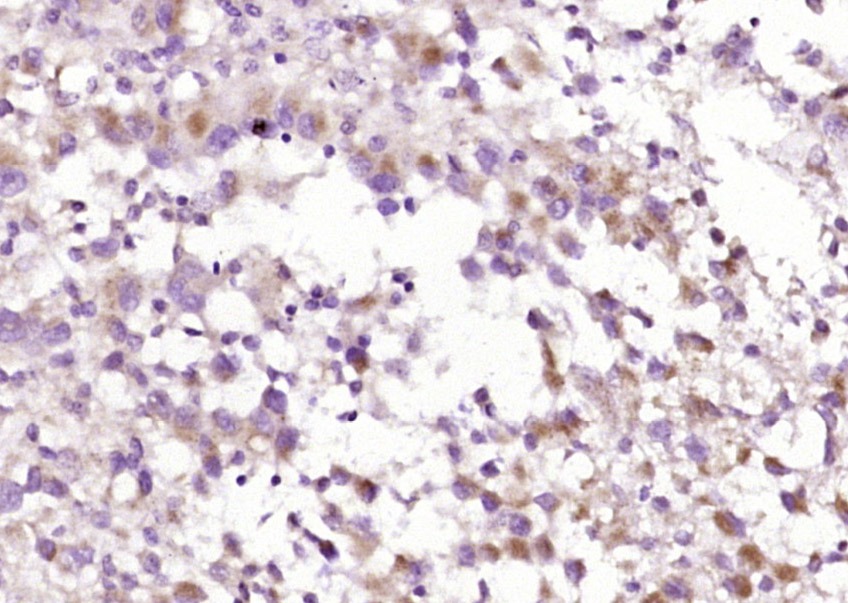Shopping Cart
- Remove All
 Your shopping cart is currently empty
Your shopping cart is currently empty
Anti-C1QC Polyclonal Antibody is a Rabbit antibody targeting C1QC. Anti-C1QC Polyclonal Antibody can be used in ELISA,IF,IHC-Fr,IHC-P.
| Pack Size | Price | Availability | Quantity |
|---|---|---|---|
| 50 μL | $221 | 7-10 days | |
| 100 μL | $374 | 7-10 days | |
| 200 μL | $527 | 7-10 days |
| Description | Anti-C1QC Polyclonal Antibody is a Rabbit antibody targeting C1QC. Anti-C1QC Polyclonal Antibody can be used in ELISA,IF,IHC-Fr,IHC-P. |
| Synonyms | complement component 1, q subcomponent, gamma polypeptide, Complement component 1, q subcomponent, C chain, Complement C1q subcomponent subunit C, C1QG, C1qc, C1Q C, AI385742 |
| Ig Type | IgG |
| Reactivity | Human,Mouse (predicted:Rat,Dog,Horse,Rabbit) |
| Verified Activity | 1. Paraformaldehyde-fixed, paraffin embedded (human brain glioma); Antigen retrieval by boiling in sodium citrate buffer (pH6.0) for 15 min; Block endogenous peroxidase by 3% hydrogen peroxide for 20 min; Blocking buffer (normal goat serum) at 37°C for 30 min; Antibody incubation with (C1QC) Polyclonal Antibody, Unconjugated (TMAB-00259) at 1:400 overnight at 4°C, followed by operating according to SP Kit (Rabbit) instructionsand DAB staining. 2. Paraformaldehyde-fixed, paraffin embedded (mouse liver tissue); Antigen retrieval by boiling in sodium citrate buffer (pH6.0) for 15 min; Block endogenous peroxidase by 3% hydrogen peroxide for 20 min; Blocking buffer (normal goat serum) at 37°C for 30 min; Antibody incubation with (C1QC) Polyclonal Antibody, Unconjugated (TMAB-00259) at 1:400 overnight at 4°C, followed by operating according to SP Kit (Rabbit) instructionsand DAB staining.   |
| Application | |
| Recommended Dose | IHC-P: 1:100-500; IHC-Fr: 1:100-500; IF: 1:100-500; ELISA: 1:32000 |
| Antibody Type | Polyclonal |
| Host Species | Rabbit |
| Subcellular Localization | Secreted. |
| Construction | Polyclonal Antibody |
| Purification | Protein A purified |
| Appearance | Liquid |
| Formulation | 0.01M TBS (pH7.4) with 1% BSA, 0.02% Proclin300 and 50% Glycerol. |
| Concentration | 1 mg/mL |
| Research Background | C1q, a subcomponent of the classical complement pathway, is composed of nine subunits that mediate classical complement activation and thereby play an important role in the immune response. Six of these subunits are disulfide-linked dimers of chains A and B, while three of these subunits, designated C1q-A through C1q-C, are disulfide-linked dimers of chain C. The presence of receptors for C1q on effector cells modulates its activity, which may be antibody-dependent or independent. Macrophages are the primary source of C1q, while anti-inflammatory drugs as well as cytokines differentially regulate expression of the mRNA, as well as the protein. However, its ability to modulate the interaction of platelets with collagen and immune complexes suggests C1q influences homeostasis as well as other immune activities, and perhaps thrombotic complications resulting from immune injury. Defects in C1q-A, C1q-B and C1q-C cause inactivation of the classical pathway, leading to a rare genetic disorder characterized by lupus-like symptoms. |
| Immunogen | KLH conjugated synthetic peptide: human C1QC |
| Antigen Species | Human |
| Gene Name | C1QC |
| Gene ID | |
| Protein Name | Complement C1q subcomponent subunit C |
| Uniprot ID | |
| Biology Area | Classical Pathway,Complement,Synapse marker |
| Function | C1q associates with the proenzymes C1r and C1s to yield C1, the first component of the serum complement system. The collagen-like regions of C1q interact with the Ca(2+)-dependent C1r(2)C1s(2) proenzyme complex, and efficient activation of C1 takes place on interaction of the globular heads of C1q with the Fc regions of IgG or IgM antibody present in immune complexes. |
| Molecular Weight | Theoretical: 23 kDa. |
| Stability & Storage | Store at -20°C or -80°C for 12 months. Avoid repeated freeze-thaw cycles. |
| Transport | Shipping with blue ice. |

Copyright © 2015-2025 TargetMol Chemicals Inc. All Rights Reserved.